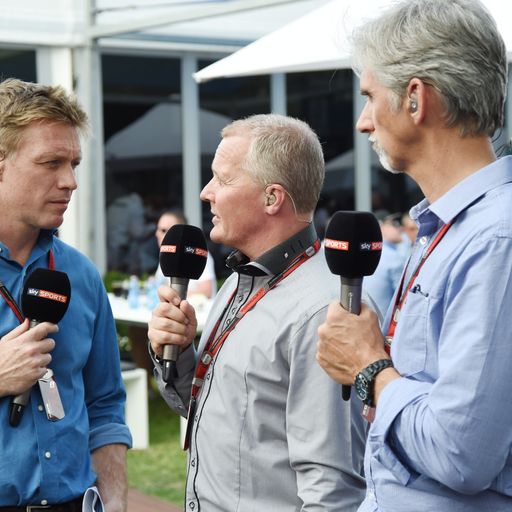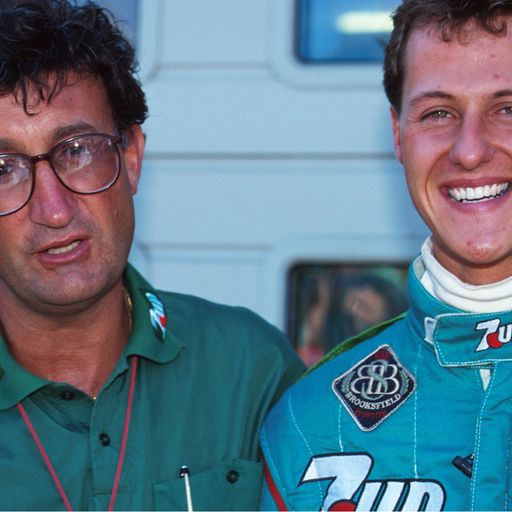Anthony Davidson's Spa track guide ahead of Belgian Grand Prix
The Sky F1 expert is your guide for a lap of the legendary circuit.
Monday 29 August 2016 10:46, UK
The greatest Grand Prix circuit in the world? Many would say so and here Sky Sports F1's Anthony Davidson provides his expert corner-by-corner guide to this compelling 4.35-mile challenge...
It's a bit of a short run down to Turn One, La Source, and you often see cars make a bit of contact there at the start. You've also got to watch out for not running over the white line on the exit because you'll pick up a penalty if you run out too far and gain an advantage from that.
But during a normal full-speed lap it's one of those corners that goads you into braking a bit too late; there's a dip down as you turn in and you've got to hug the inside kerb as much as possible. There's also a wall on the inside to guard the pit-lane exit. Normally the rear of the car goes a bit light on braking and as you turn in you pick up quite a bit of understeer mid-corner and it's therefore quite easy to understeer wide and miss the apex.
It's a very important corner as that takes you down the hill towards Eau Rouge. It's quite a long straight so it's crucial to carry that momentum down because you're then flat out from the moment you commit to going full throttle at the exit of La Source all the way up through Eau Rouge, up the Kemmel Straight all the way to Les Combes.
In fact the full throttle period from La Source to the Les Combes chicane is the longest of the season and lasts 23 seconds! So that's why it's so crucial to get a good exit out of the first hairpin and why a big boost of KERS out of La Source is important to propel you onto that mightily-long straight.
Eau Rouge is not really the corner it used to be but you still have to pick your way through there and not scrub off too much speed - especially when you've got old tyres. It's easy to be a bit too aggressive through there and maybe pick the wrong line, which means you can scrub off speed even if you're completely flat out.
In a racing situation you approach Eau Rouge at 180-190mph and if you're behind another car you're going to pick up a lot of turbulent air and it's very hard to follow another car through there closely. That's one of the downfalls of the possibilities of overtaking - the front will just wash out and you have to back off it.
It's a single-file corner when you're at full racing speed. We often see at the start on the run down there cars going through side by side but in general high-speed running you can't take it full throttle, side by side.
Going up the hill the car always feels quite slow because it is a constant elevation change of climbing and climbing to the highest point on the track. Therefore braking into Les Combes is pretty good because you're still climbing up hill. You brake just after the 100-metre board, there's a kerb on the left-hand side that you can use as your reference as well and when that begins it's time to start applying the brakes.
Les Combes is a tricky corner in that it can be quite easy to outbrake yourself. If you do you've now got a lovely bit of run-off area you can use, but you've got to pick your way through the 'sleeping policeman'. In normal running you've got to attack the right-hand kerb quite heavily and make sure that the car can pivot quite well there and sacrifice your exit to line up for the next left-hander.
This is the classic part of the circuit to complete an overtaking move, outbraking your opponent into the chicane on the inside. To try to combat this you often see cars moving to the right-hand side of the straight to protect their line and that does actually make it quite difficult to overtake because trying to get around the outside of that corner is very tricky.
Going into the next left-hander, Turn Six, normally you pick up a bit of understeer through there from mid-corner to the exit and it's easy to run out too wide and sacrifice the Malmedy section of the track, thus making it a tighter corner than it should be. So it's important to keep the car to the left-hand side as much as possible so you can get a clean run through Malmedy and down the hill towards Rivage, where they've also created a bit more run-off these days.
It used to be a tricky corner in that there was a bump on the inside just as you turned in and then you had a gravel trap to catch you out at the last minute, whereas now the bump's been pretty much removed and you've got a lovely bit of tarmac. So the challenge has definitely gone from that corner. It's therefore now pretty simple and it's a bit like a roundabout in that you just find the natural speed of the tyre adhesion and you have a constant lock throughout the corner. The car always tries to understeer as it goes downhill and sometimes on exit it can snap on you violently as you try to get the power back down.
Next you bring the car back over to the right-hand side to try and feed it into the tricky Turn Nine - the corner with no name and which has never had a name! You've got to get the inside kerb hooked up and use all of the available exit kerb as well for the run down the hill towards Pouhon. It's a particularly tricky corner in the wet: if you run out too wide on the exit kerb it can easily spin the car round to the inside. I think we saw Vitaly Petrov do that in his Renault days. Certainly if you've got a situation where you've got a dry line, you don't go anywhere near that kerb.
So then we're into Pouhon, which although unfortunately named, is the turn on the track that really highlights a strong car and one where you've got to carry as much speed as possible all the way through. It's a fast entry; you're in seventh gear, flat-out, probably 185mph before just braking and shifting down one gear into sixth. You just dab the brakes slightly.
For the cars at the back of the grid it will be a bit more of a heavy brake, and most certainly, downshifting at least one gear into there and fighting the car all the way through. Again, it's a corner where you don't want to get on the kerbs on the outside in the wet but if you do and the car does spin there's a huge amount of run-off which also used to be gravel trap.
It really is a great corner where the G-Force builds up all the way through it. You really feel the force on your neck - especially after a handful of laps - and it's a really vital part of the lap to get right, especially in qualifying.
Once you've successfully navigated Pouhon, the track continues to drop down towards Turn 12. It's a really good corner, under the bridge. You can brake really late into this corner, carry a lot of speed into it and brake all the way into the corner and trailbrake. Pick up a bit of the kerb on the inside if you want - just anything you can do to try and keep the inside as far on the inside as possible before flicking the car to the left-hand side into Fagnes.
Again, using a bit of kerb on the inside and just trying at that point in the middle of the corner to tease the throttle on as much as you dare because the rear's quite light at that stage. You're willing the car on to carry momentum at that point because you really feel like it's a fast-flowing point of the lap but you don't want to pinch it too much and slow the car down and lose that momentum.
That leads you into Stavelot, Turn 14, and that's a really nice corner as well. Bring the car back over to the left-hand side, brake in a nice straight line, down into third gear, use the kerb on the inside to hook the car up and then use all of the kerb on the outside. Like at the start of lap coming out of La Source, it's important to get back on the throttle as soon as possible because you're now on throttle for a long, long time here and it's a potential overtaking move as well.
Curve Paul Frere, or Turn 15, is just about full throttle and it's a real challenging corner. There's not much run-off here and if you were to lose it here you really would have a big crash. You don't really see many cars go off there anymore, but they used to when it was a bit more tricky with less downforce.
That flows you onto the back straight part of the circuit and into Blanchimont which is an easy kink to the left, flat-out. In the rain it's a lot more challenging as it's not full throttle, so you can make up a lot of time there if you're feeling brave in wet conditions. But in normal circumstances in the dry you can definitely follow a car through there full throttle and that will nicely lead you into a potential overtaking move at the Bus Stop chicane.
The Bus Stop has changed a lot over the years but I quite like this particular version of it. It's maybe not quite as good as the old Bus Stop chicane but it's certainly challenging. It's bumpy on the way in there, you haven't got much of a brake reference and you can easily lock up the rear-end, which will then lock the front in return, and you'll run off wide and off the track. It's a hard corner to judge the braking speed because you're arriving at 190mph and braking all the way down into second gear at 45mph.
If you've done a good lap in qualifying at this point it's a real tense moment inside the cockpit because you know it can go horribly wrong right at the last. But it's another part of the lap that if it goes right you can gain another handful of time. Very tricky to thread a car through there as it goes right and then left as it continues to climb up the hill and the car feels very cumbersome and very difficult to change the direction.
You don't really want to go touching any kerbs on the apexes because that's really going to upset the car and lose you more speed. So overall it's one of the only slow-speed, really technical points on the track but I think it's definitely got its place and you need that.
So, a great lap Spa and I wish I was still out there doing it in Formula 1!











